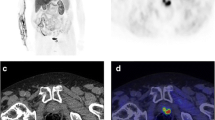Abstract
The diagnosis of prostate cancer leaves some questions without answers. The different diagnostic techniques are limited in three situations: (1) staging of the tumour: identification of node involvement, (2) quantification of the tumour volume and its location inside the gland, (3) premature identification of relapse after radical treatment. These are the three problems that we need to consider in the diagnosis of prostate carcinoma. Imaging techniques can tell us the morphological alterations in the structures and organs. Positron emission tomography (PET) introduces a new way of identifying damage by counting metabolic activity. The tracers are substances that are marked with a radioactive molecule that is picked up more readily by the tumours. The presence of these substances in a set anatomic zone means higher consumption and therefore more metabolic activity. The radiotracer most frequently used in PET is glucose marked with fluoride 18. The first studies with marked glucose and prostate tumours started at the end of the 1990s. There are many contradictions in the results of these studies due to renal elimination, which produces an accumulation in the urinary tract and does not correctly show the prostate zone and iliobturator nodes area, and its capitation by zones with inflammatory process or prostatic hyperplasia. Choline is a substance that is present in cellular membranes. When it is marked with carbon 11, it changes to a new tracer. This radiotracer has affinity with prostate damage and allows the better differentiation of malignant from benign processes. It also has the advantage of the absence of renal elimination. Trials that used choline marked with carbon 11 (11C choline) are beginning to obtain very promising results. This union of a method that identifies metabolic activity with an imaging technique increases the sensitivity in the diagnostic test and can help find the exact location of the 11C choline deposits. The PET-CT combines the PET with computerised tomography. The 11C choline PET-CT is presented as a promising technique for answering the three problems mentioned above.
Similar content being viewed by others
References
Mathews D, Orhan K (2002) Oz positron emission tomography in prostate and renal cell carcinoma. Curr Opin Urol 12:381–385
Hara T, Kosaba N, Kishi H (1998) PET imaging of prostate cancer using carbon-11-choline. J Nucl Mec 39:990–995
De Jong IJ, Pruim J et al. (2003) Preoperative staging of pelvic lymph nodes in prostate cancer by 11C-choline PET. J Nucl Med 44:331–335
De Jong IJ, Pruim J, Elsinga PH et al. (2003) 11C-choline positron emission tomography for the evaluation after treatment of localized prostate cancer. Eur Urol 44:32–39
Liu IJ, Zafar MB, Lai YH et al. (2001) Fluorodeoxyglucose positron emission tomography studies in diagnosis and staging of clinically organ-confined prostate cancer. Urology 57:108–111
LópezJ, Boan J, Rioja J et al. (2003) Metástasis pulmonar solitaria tras prostatectomía radical. Actas Urol Esp 27:637–639
Picchio M, Messa C, Landoni C et al. (2003) Value of 11C-choline-positron emission tomography for re-staging prostate cancer: a comparison with 18F fluorodeoxyglucose-positron emission tomography. J Urol 169:1337–1340
Sanz G, Robles JE, Gimenez M et al. (1999) Positron emission tomography with 18 fluorine labelled deoxyglucose: utility in localized and advanced prostate cancer. BJU Int 84:1028–1031
Yeung H, Schoder H, Larson S (2002) Utility of PET/CT for assesing equivocal PET lesions in oncology—initial experience. J Nucl Med :43:32
Author information
Authors and Affiliations
Corresponding author
Rights and permissions
About this article
Cite this article
Sanz, G., Rioja, J., Zudaire, J.J. et al. PET and prostate cancer. World J Urol 22, 351–352 (2004). https://doi.org/10.1007/s00345-004-0418-8
Received:
Accepted:
Published:
Issue Date:
DOI: https://doi.org/10.1007/s00345-004-0418-8




